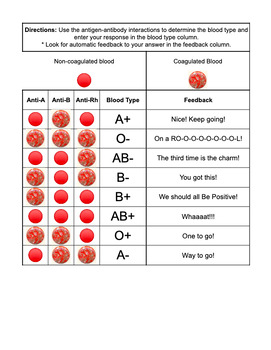Interactive Blood Typing Practice
Infinite Mind
0 Followers
Resource Type
Standards
NGSSHS-LS3-1
NGSSHS-LS4-1
NGSSHS-LS3-2
Formats Included
- Google Sheets™
- Internet Activities
- Excel Spreadsheets
Pages
1 page
Infinite Mind
0 Followers

Made for Google Drive™
This resource can be used by students on Google Drive or Google Classroom. To access this resource, you’ll need to allow TPT to add it to your Google Drive. See our FAQ and Privacy Policy for more information.
Description
Utilize this form to help students understand blood typing. Students get immediate feedback in the form of encouraging prompts to let them know if they are on the right track while completing this interactive blood typing exercise in Google Sheets. Great for Biology and Forensics. Answer key is included on a second tab. Make a copy and remove the answer key before distributing to students.
Total Pages
1 page
Answer Key
Included
Teaching Duration
N/A
Report this resource to TPT
Reported resources will be reviewed by our team. Report this resource to let us know if this resource violates TPT’s content guidelines.
Standards
to see state-specific standards (only available in the US).
NGSSHS-LS3-1
Ask questions to clarify relationships about the role of DNA and chromosomes in coding the instructions for characteristic traits passed from parents to offspring. Assessment does not include the phases of meiosis or the biochemical mechanism of specific steps in the process.
NGSSHS-LS4-1
Communicate scientific information that common ancestry and biological evolution are supported by multiple lines of empirical evidence. Emphasis is on a conceptual understanding of the role each line of evidence has relating to common ancestry and biological evolution. Examples of evidence could include similarities in DNA sequences, anatomical structures, and order of appearance of structures in embryological development.
NGSSHS-LS3-2
Make and defend a claim based on evidence that inheritable genetic variations may result from (1) new genetic combinations through meiosis, (2) viable errors occurring during replication, and/or (3) mutations caused by environmental factors. Emphasis is on using data to support arguments for the way variation occurs. Assessment does not include the phases of meiosis or the biochemical mechanism of specific steps in the process.



